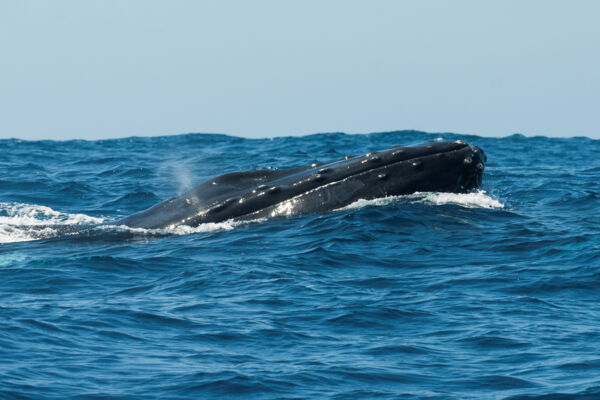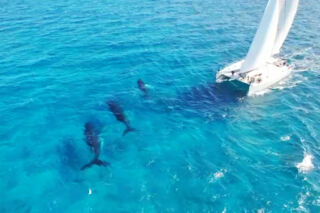Salt Cay Whale Watching

Annually during the winter season, humpback whales migrate from the northern Atlantic to warmer waters near the Caribbean. Typically originating from the vast waters surrounding north-western Europe, Greenland, Iceland, Canada, and from inside the Arctic Circle, the majority of whales head for a relatively small region near the Turks and Caicos and the Dominican Republic.
The attraction of this region is a few shallow banks, which include the Silver Banks, Mouchoir Banks, and the Gentry Banks. The humpback whales make the long swim down to the Caribbean to give birth and to mate.
Whales can be spotted in the deep water off of the Caicos Islands, but the best place in the country for humpback whale watching is in the Turks Islands Passage near Grand Turk and Salt Cay.
The Turks and Caicos Islands are situated on an underwater plateau that rises abruptly 10,000 feet (3,048 m) from the ocean floor. This plateau is partially split by the 6,000-foot-deep (1,830 m) Turks Islands Passage which separates the Turks Islands from the Caicos Islands.
Whales are naturally funneled through this channel, and the naturally increased density of whales makes Salt Cay and Grand Turk unrivaled sites for whale watching.
It’s often possible to see whale calves with their mothers, along with pods of five or more whales.
Male humpbacks sing a 10–20 minute complex and unique song, which can be heard for miles underwater. It’s not certain what this is for, but evidence suggests that it’s a mating call.
Whale Watching from Salt Cay

Unlike whale watching excursions offered at other destinations, smaller boats—often the same vessels used for diving and fishing expeditions—are the boats used for whale watching. Although they may not be as comfortable as a purpose-built larger vessel, such boats are often able to provide a closer view of the whales.
Snorkeling with Whales
Depending on the mood of the whales, the ocean conditions, and other factors, it may be possible to snorkel with the whales.
If the opportunity presents itself, take advantage of it. An in-water encounter will be an unforgettable experience.
Responsible Whale Watching Tips
As friendly as they can be, the humpback whales that migrate through the Turks and Caicos are, first and foremost, wild animals. The Turks and Caicos Department of Environment and Coastal Resources (DECR) has guidelines for interacting with marine mammals, such as dolphins and whales, in the islands. For the whales’ safety and for yours, it’s important to practice the following recommended behaviors when whale watching.
One of the benefits of whale watching in the Turks and Caicos is being able to get in the water with these majestic creatures. When snorkeling near a humpback whale:
- Wear snorkeling vests in the water.
- Avoid splashing your arms or legs excessively.
- Do not approach the whale—instead, let it approach you if it chooses to.
- Do not freedive into the whale's space.
- Do not try touching the whale, under any circumstances.
- Keep your distance from pregnant females to avoid being seen as a threat.
- If a marine mammal charges towards you, get out of the water immediately.
Whether you are in the water with a humpback whale or observing it from the deck of a tour boat, know that you should never litter in their environment or try to feed them. Feeding marine mammals is not only dangerous—it’s illegal under Turks and Caicos law.

